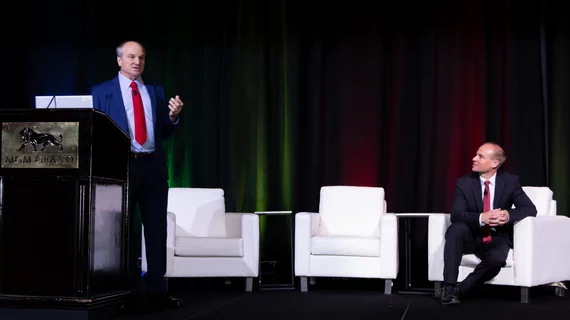Radiology and pathology unite to produce $1M in potential revenue enhancements to 1 provider
LAS VEGAS—Radiology and pathology experts on Monday detailed how integration of the two specialties has the potential to produce hundreds of thousands in revenue enhancements while dramatically improving patient care.
Physicians with the University of Texas Medical Branch made their case for such an approach at the Radiology Business Management Association’s annual meeting in Las Vegas. Current care models rely on inefficiencies and siloes to reach a patient’s final diagnosis. And when this process is led by surgeons or other procedure-focused specialties, the path likely leads to a predetermined end point.
“We all have RVUs that we have to answer for, and we all have bosses that we need to deliver to,” Christopher Zahner, MD, clinical pathology director at UTMB, told attendees. “We’ve all heard of this concept where, to anyone with a hammer, everything appears to be a nail,” he added later.
The Galveston, Texas, academic health science center has sought to change this paradigm, envisioning the care pathway like a collection of dominoes where radiology and pathology is the critical first tile.
“We need to put diagnostics first. Right now, we are the backseat drivers. We need to become the front-seat drivers,” Eric Walser, MD, the John Sealy Professor and chairman of radiology at UTMB, told attendees, adding “there is going to be some significant resistance from people.”
For the center, this has spelled a shift toward “integrative diagnostics.” The two speakers pointed to a 2023 article, co-authored by noted radiologist Geraldine B. McGinty, MD, MBA, that explains this approach [1]. In ID, radiologists, pathologists and others work as a team with shared access to continuously updated data. Scientists and clinical decision support tools extract relevant information and formulate “dynamic differential diagnosis and management pathways,” McGinty et al. wrote. And predictive analytic tools can help streamline care pathways so the necessary radiology exam or other diagnostic test is expedited.
UTMB has aimed to implement this new approach, which includes standardized and merged radiology and pathology reports, along with a shared digital platform and structure for real-time collaboration. Doing so presents potential barriers, forcing clinicians to relinquish diagnostic workup and “receive it instead.” Those who seek diagnostic integration also must overcome institutional resistance to change, disparate electronic medical records systems, data privacy concerns, and payer authorization hurdles. But engaging stakeholders and phasing-in technology adoption can lead to success, the speakers noted.
“Money talks” in trying to make this argument to leadership. Using smart diagnostics early in the care process can bolster revenue streams. They gave the example of opportunistic screening, using chest X-ray to also check for aortic disease and osteoporosis, or chest CT to assess coronary artery calcifications. Walser estimated this could conservatively lead to $1 million per year in revenue enhancements for an organization like his.
UTMB is aiming to establish a dedicated diagnostic center to handle this work. There, for example, a patient would walk in with a knee pain, nurses would assess and do a diagnostic work up, and try to reach the answer first, Walser noted. He already foresees resistance from surgeons. But Walser highlighted the economic power of combining the two specialties, with pathology and radiology recording a combined margin contribution of $55 million to UTMB last year, dwarfing that of surgery.
“House of surgery will have to give up the workup and relinquish it to the radiologists and pathologists, and they already don’t like us,” Walser said.

